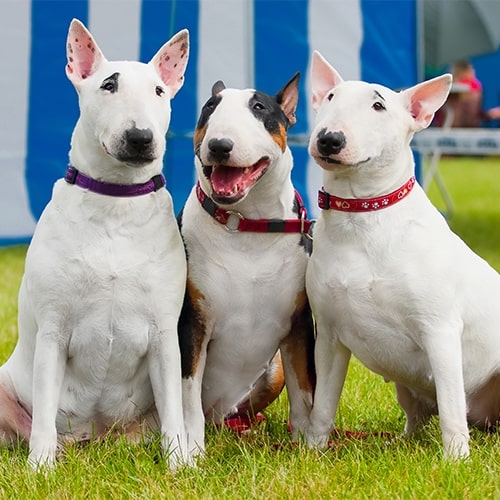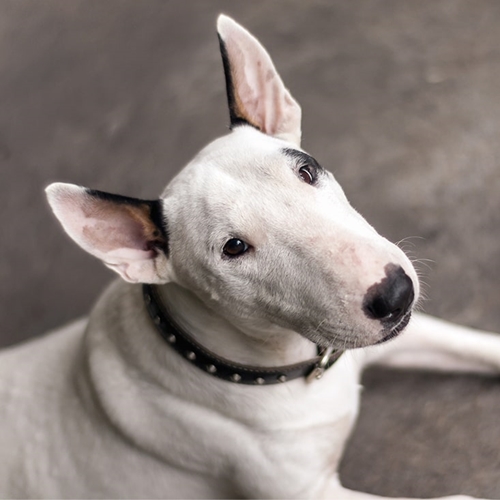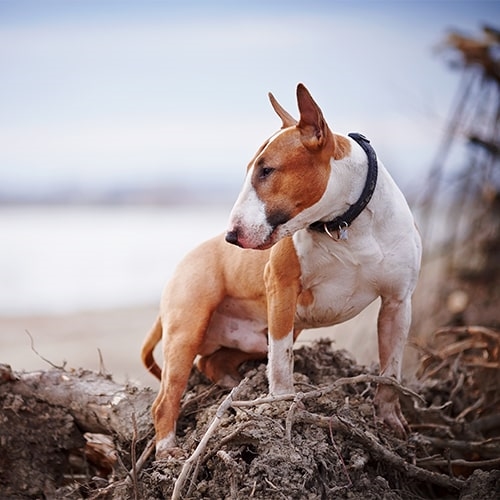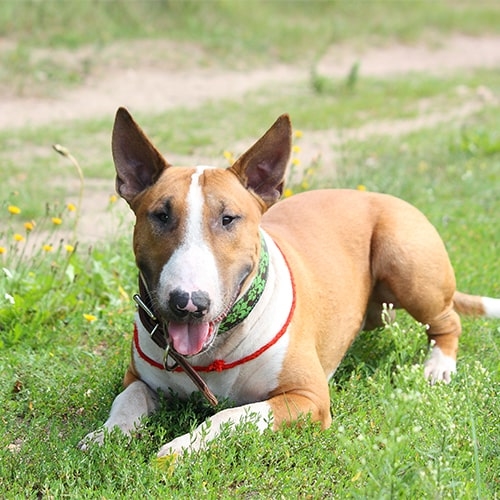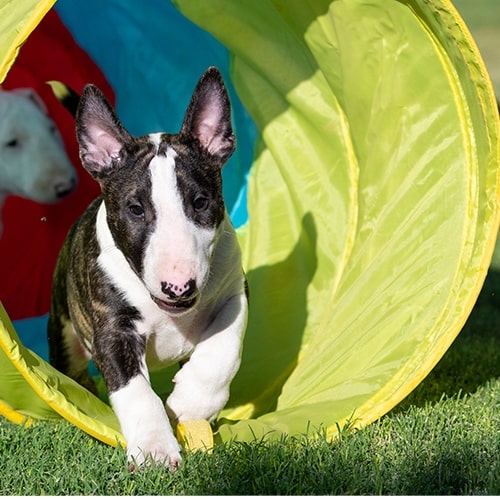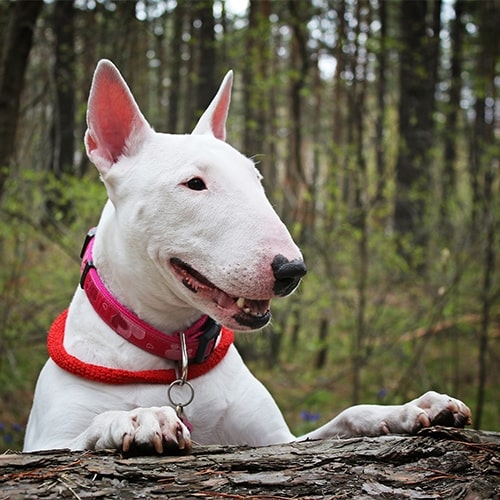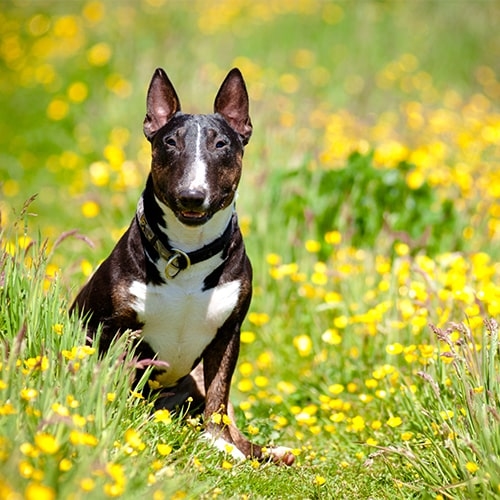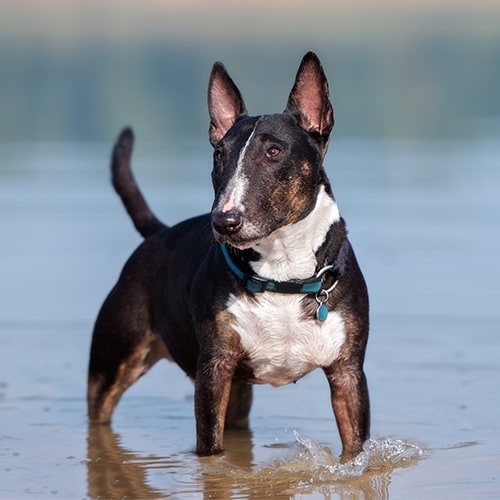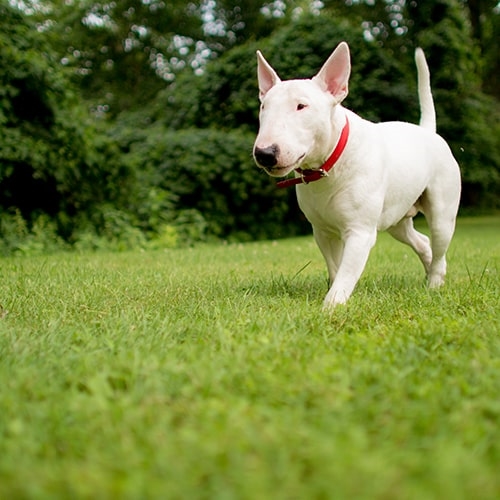| Size | Medium |
|---|---|
| Average height | 51-61 cm |
| Average weight | 22-31 kg |
| Average lifespan | Over 10 years |
| Minimum exercise (per day) | 1 hour |
| Coat length | Short |
| Minimum cost (per month) | £80 |
English Bull Terriers are active, loving dogs known for their distinctive faces. While they make great pets, English Bull Terriers are known for being challenging at times. Like all dogs, any training and socialising will need to start early and be consistent.
English Bull Terriers suit active families really well as they have high energy levels and love human company. They are great for experienced owners who have the patience to train them.
Common health problems in English Bull Terriers
Despite their great personalities, like many purebred dogs English Bull Terriers have health problems linked to their breed. There is currently testing and screening for some of the problems Bull Terriers can have. Often, Breed Clubs will also be able to provide advice on what tests your breed may need and where to get these done. Make sure the parents of your puppy have had the relevant health screening to reduce the chances of your puppy being affected by these upsetting conditions.
Bull Terriers are amongst a group of breeds classed as ‘Category Two’ by The Kennel Club. These are breeds of dog that have been highlighted as having ‘points of concern’ – features which, if exaggerated, might affect the breed in the future and cause health and welfare concerns. For Bull Terriers, this is because of their “Roman” nose which can mean their teeth don’t line up properly, causing problems with opening and closing their mouth. If you want to minimise the risk of your dog getting problems due to exaggerated features, you can read our advice on choosing a pedigree dog.
Some common health conditions English Bull Terriers develop include:
- Deafness – where dogs are born without hearing. Brainstem Auditory Evoked Response (BAER) testing should be used to screen puppies for this.
- Lethal acrodermatitis – a genetic disease that causes fatal skin and growth problems. This only affects white Bull Terriers and a DNA test can screen for carriers of this.
- Kidney problems – urine tests can screen parents for this.
- Heart problems – heart scans can screen parents for heart valve problems.
- Luxating patellas – where the kneecaps slip temporarily out of place. Before breeding parents can be checked by a vet for this.
- Atopy – allergies causing itchy skin and ear infections.
Caring for your English Bull Terrier
Bull terriers can be a great addition if you're looking for a canine companion. They are very lively and like to have company as much as possible, so you'll need to make sure you're around for a good portion of the day.
English Bull Terriers and barking
Like all dogs, Bull Terriers are likely to make a bit of noise every now and again. How much noise your dog makes will be down to their individual personality. If you’re having problems with excessive noise or barking, we recommend seeking the advice of an accredited behaviourist.
Training and socialisation
You will need to be firm but fair with your Bull Terrier as they can have a strong-willed nature. Training needs to be ongoing and everyone who looks after your Bull Terrier will need to follow the same rules.
If you get a puppy, you’ll need to continue to socialise them and use positive, reward-based training from day one. It might be hard to be consistent at first but it’s important that they learn how to behave properly to become great pets. You can check if your local vet runs puppy parties or find local puppy groups online or in the newspaper so you socialise your puppy with other dogs (as soon as they’re fully vaccinated).
Exercise
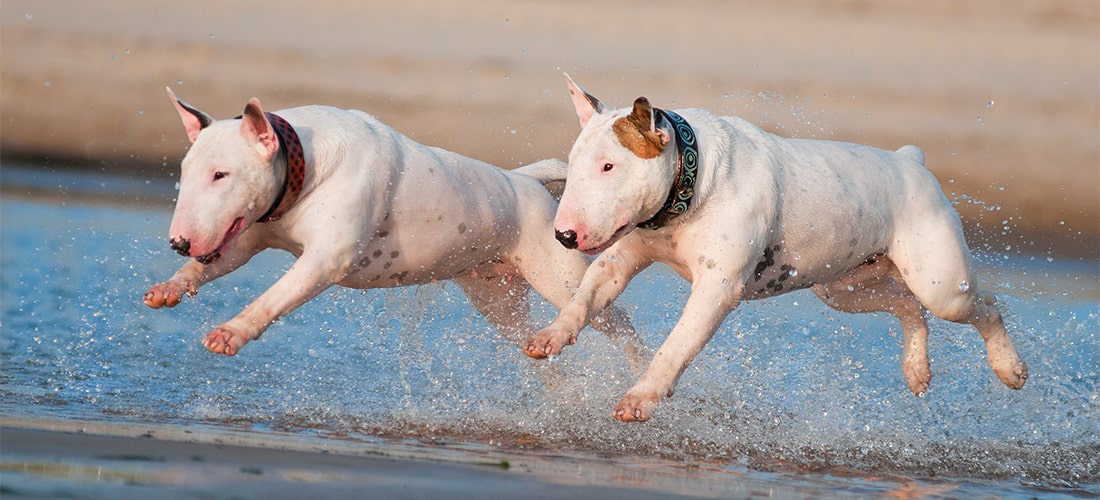
Like many breeds, Bull Terriers are lively and can get a little boisterous if they’re not given chance to get rid of all their energy.
Your Bull Terrier will need at least one hour of exercise a day. This should include walks, with extra playtime and a good amount of mental stimulation so they don’t get bored. Check out our pages to find out how much exercise your dog needs, or even find exercises you can do together.
It’s usually best if you split your dog’s exercise across the day rather than trying to do it all in one go.
Grooming
English Bull Terriers have fairly low maintenance coats, which means you won’t need to groom them much. Giving them a brush once a week should be enough to keep their coat looking healthy and shiny.
You’ll also need to check your dog’s ears regularly to make sure they’re clean and catch any irritation or infections early as Bull Terriers are more prone to developing skin allergies. Check with your vet as it may be worth regular ear cleaning to prevent problems if your dog is at risk.
English Bull Terriers and children
Bull Terriers love people! As long as your dog is socialised properly, they should get along really well with people of all ages. However, as they can be a bit excitable, they are better with older children. Always supervise your dog with children of any age and adults unfamiliar with your dog so playtime doesn’t get rough. Make sure you can recognise the signs of unhappiness or anxiety in your dog to help avoid any conflicts.
English Bull Terriers and other pets
Some Bull Terriers can be nervous or even aggressive around other dogs if not socialised, which is why socialising them well and early is so important. A well-socialised Bull Terrier is likely to be more relaxed around other dogs.
If your dog has grown up with another pet in the home from a young age they can get on well with them. As they have a high prey drive, it’s always best to be careful around cats and other small animals and never leave them unattended together, even if your dog knows them well.
Food
Your English Bull Terrier’s diet will vary depending on their age and any health conditions they may have. You’ll need to feed them a complete, balanced dog food to keep them slim and healthy.
Your vet will be able to tell you how much your dog should be eating. You should feed a healthy Bull Terrier a good quality, commercially available and complete dog food and it’s usually recommended to split their daily allowance into two meals. If you give your dog an occasional treat or use treats for training, remember to take this into account and reduce their daily allowance. Treats shouldn’t make up more than 10% of their calories or they can unbalance their diet.
You should try to feed your dog at the same time every day to get them into a routine. Remember to leave a gap after eating and before exercising.
The cost of owning an English Bull Terrier
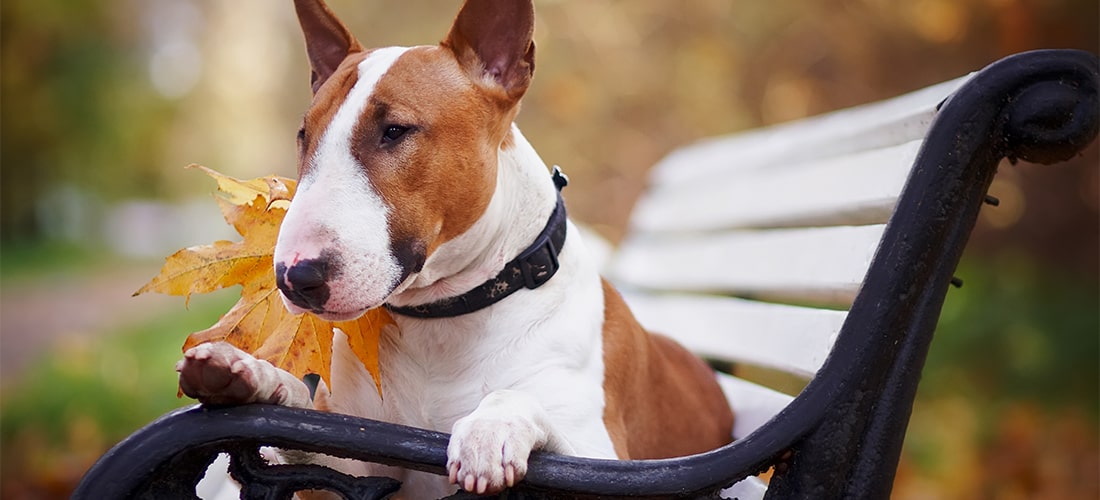
Having an English Bull Terrier will cost a minimum of £80 per month after purchase and set-up costs and up to £13,000 across their lifetime.
Costs you’ll need to think about include:
Purchase costs
Adopting an adult dog from a rescue centre may be a more cost-effective option, as well as having the added advantage of offering a home to a pet without one – check if the rehoming centre you’re looking at asks for a donation for rehoming.
If instead you’re buying a Bull Terrier puppy from a breeder, you’ll need to factor in this cost. Beware unusually cheap puppies as they could come from a puppy farm. If you want to buy a pedigree puppy, we recommend looking for a Kennel Club Assured breeder as they have to do extra health tests and meet high standards.
Set-up costs
- Puppy vaccines – if you rescue a dog, reputable centres will often vaccinate them for you. Remember that ongoing booster vaccinations will be needed to continue their immunity.
- Neutering – you should usually arrange for your dog to be neutered at around 6 months old, though your vet will be able to advise you exactly when is best. Check prices at your local practice as these will depend on your vet and where you live. Some rescue centres will neuter any dogs they rehome, saving you this cost.
- Equipment – including a collar and tags, lead, harness, dog beds, dog bowls, pet-safe toothpaste and toothbrushes, grooming brushes and toys. Keep in mind that all these will need to be replaced with wear or damage or if your dog outgrows or damages them!
Ongoing costs
- Food.
- Preventive healthcare – budget for routine vet visits to help stop your dog getting ill and catch any problems early. They need annual check-ups, vaccinations and regular flea and worming treatments. Check if your vet offers a health care plan as this can help spread the cost throughout the year.
- Vet bills* or pet insurance – if you don’t have pet insurance and your dog needs veterinary treatment for an injury or illness, costs can rapidly mount up. Check what’s covered and what isn’t when comparing policies.
- Accessories – including lots of poo bags, replacing worn toys and grooming accessories, buying doggy toothpaste and any other extras they might need.
Other costs
- Training – basic training is very important and dogs can benefit from formal classes. Some dogs may have, or develop, behavioural problems which might need professional management.
- Boarding – you may also need to budget for boarding or dog sitting costs if you are planning to go away from home on holiday.
- Dog walkers/day-care – you might consider a professional dog walker to keep your dog happy and healthy if you’re unable to get out with your dog enough yourself, or to look after them during the day if you need to be out for more than four hours.
* It’s always better to plan ahead and budget or get pet insurance in case your pet gets injured or unwell. If you are having difficulty with veterinary costs, you can check if you are eligible for treatment at PDSA here.
When you welcome a new dog into your life, consider getting dog insurance straight away before any signs of illness start. This will give you peace of mind that you have some financial support if they ever get sick.
Fun facts
- An English Bull Terrier called Spuds featured in Budweiser adverts in the 80’s.
- They are a popular breed with royalty – Princess Anne is known to have her own Bull Terriers.
- They’re considered the clowns of the dog world due to their fun personalities and mischievous nature.
- Bull Terriers have triangular eyes and are one of the few recognised breeds to do so.
Getting an English Bull Terrier
Do plenty of research before you get a Bull Terrier. They are lively dogs who need plenty of love and attention from their owners with enough playtime to satisfy their instincts. Make sure you are fully committed before getting a dog.
Rehoming centres
There are plenty of rescue centres across the country where you may find an English Bull Terrier. Breed-specific rescues that specialise in Bull Terriers are out there too. You’ll need to ask any rescue centre about the dog’s history to make sure they will be comfortable in your home. Good rescue centres should let you know of any health and behaviour problems.
Breeders
If you buy a Bull Terrier puppy from a breeder, make sure your puppy will be well socialised and have all necessary health checks and vaccinations. We recommend looking for a Kennel Club Assured breeder as they meet higher standards. We’ve put together some advice to help you find a good breeder.

